
How To Do Email Marketing In 2025
Email marketing is far from obsolete–it’s one of the most powerful digital marketing channels today.
Despite the rise of social media and SEO, email continues to deliver exceptional ROI, with $42 earned for every dollar spent.
Email’s ability to directly reach and engage your audience makes it so effective. But to unlock its full potential for your business, you need to know how to use it strategically.
In this guide, you’ll learn what email marketing is and how it works, why it is important for all businesses, how to get started right away, as well as discover the essential email types, examples, and email regulations.
Design and deliver emails on one platform
Pick your favorite template. Customize it. Hit send.
Try for freeWhat is Email Marketing?
Email marketing is a powerful tool for informing, educating, and persuading your audience to take action. It includes newsletters, promotional emails, transactional messages, and company announcements.
With the integration of AI into their campaigns, brands can now better convert prospects into loyal customers, enhancing engagement and driving results.
Whether you run a small business, an online store, or a large enterprise, the key to success lies in understanding your audience’s preferences and crafting impactful campaigns tailored to them.
Remember, email marketing requires user consent. Treating your presence in their inbox respectfully is essential—overstepping boundaries or assuming your emails deserve special attention can backfire.
How Does Email Marketing Work?
Email marketing is a highly effective digital strategy that’s easy to learn and automate, making it accessible for beginners to quickly master and achieve success.
Specifically, email marketing involves three essential components:
An email list
An email list is essential for launching email marketing campaigns. This database consists of individuals who have willingly opted in to receive updates and promotions from your brand.
To ensure the success of your campaigns, it’s equally important to keep your list active and engaged.
There are various ways for you to build your email list. One of the most effective ways is to provide an incentive your target audience will be interested in. In return, they will provide you with their email address.
These incentives are called lead magnets, and they usually are:
- coupons
- ebooks
- downloadable content
An Email Service Provider (ESP)
An ESP is software that helps you create, send, and manage email campaigns effectively.
It offers tools to segment your audience, personalize content, and analyze performance, making engaging with subscribers and achieving your marketing goals easier.
With an ESP, you can also set up automated email campaigns triggered by your audience’s behavior, ensuring timely and relevant interactions.
For example, you can create a special offer reminder when someone browses a specific page on your website and doesn’t make a purchase.
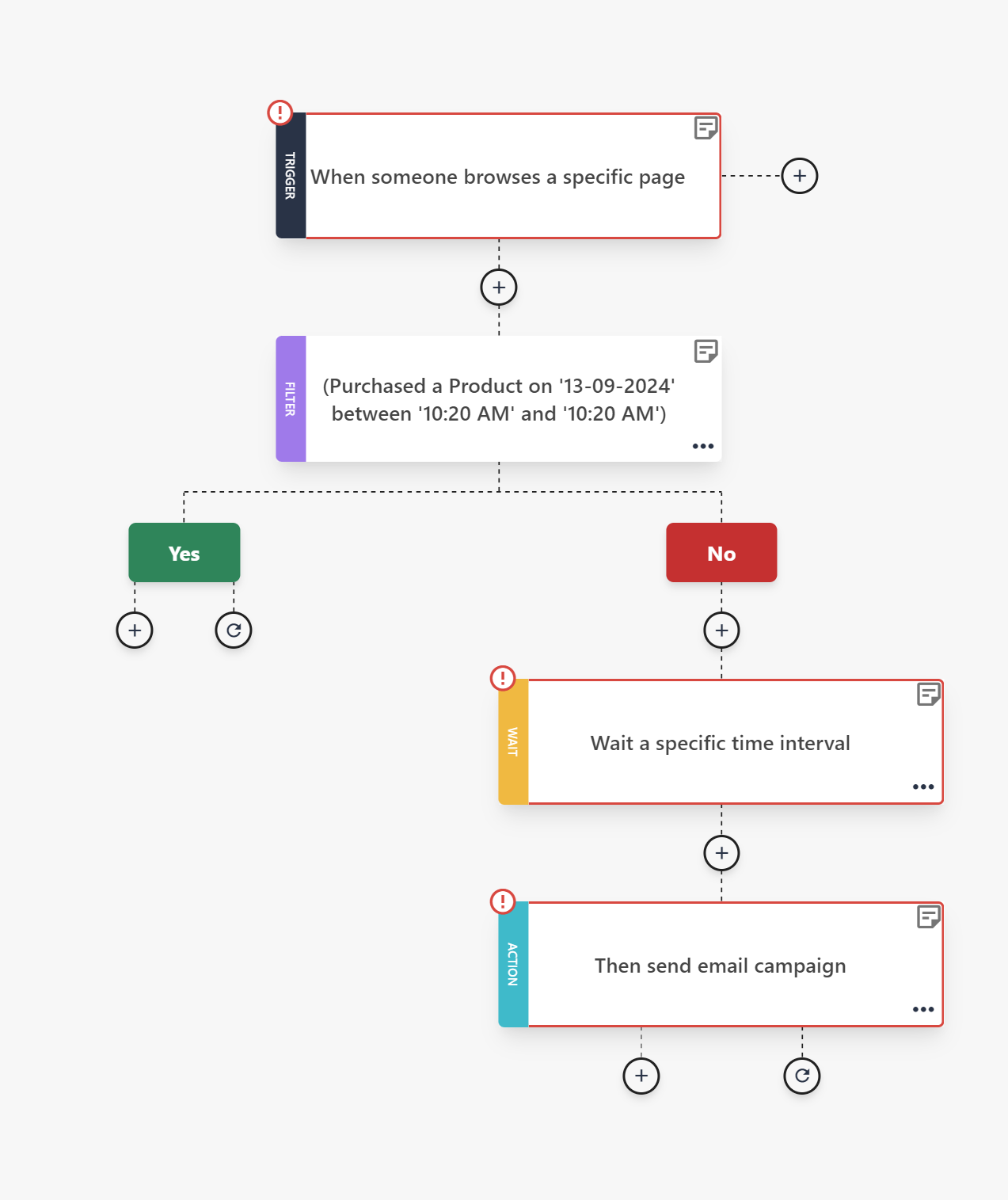
This way, almost every interaction can be personalized, thus achieving higher engagement and conversion rates.
Lastly, modern ESPs can integrate with other marketing tools you use, such as CRMs and eCommerce platforms, so that you can streamline your processes.
A specific goal
The final element is, of course, a clearly defined business objective. Without it, you risk sending marketing messages that your audience will ignore.
To give you some examples, email marketing can be used to:
- generate new leads
- boost brand awareness
- drive more sales
- increase engagement with the brand
- build a relationship of trust with the audience
Having a clear goal before crafting your email marketing campaigns ensures you are on the right path to success.
Benefits of Email Marketing
In today’s competitive marketing arena, standing out requires smart strategies. With email marketing, you can become a gladiator, ready to conquer challenges and build a thriving business.
Here are the top benefits of email marketing and why it’s a must-have in any successful digital strategy.
It has measurable results
Email is a highly effective tool for turning leads into customers, often surpassing the conversion potential of social media platforms. Its direct and personalized approach makes it essential to any successful marketing strategy.
Moreover, people consider email a more trustworthy and professional channel. And with the right elements, like user reviews and testimonials, a single campaign can become a significant conversion asset.
Finally, let’s not forget that emails are measurable regarding open rates, click-through rates, conversions, bounces, and more.

To monitor your performance, you need a robust email marketing automation platform to equip you with advanced reporting tools.
For instance, when you sign up for a free Moosend account, the platform gives you access to real-time reporting and analytics to monitor your email performance and optimize your conversion rate.
This way, you will always know how your messages perform!
It’s one of the best communication channels
According to Optinmonster, 99% of consumers check their emails every day. That’s an insanely high percentage.
Also, 72% of people prefer to receive promotional content through emails. Unlike social media or TV ads, email is a more professional channel to receive information about products and services.
Not only that, but technology has enabled email marketers to deliver more personalized content through email marketing automation.
Here’s a simple yet personalized email marketing example by Endy:

Campaigns like this feel more personal to the recipients and have better chances of receiving click-throughs. Tools like Moosend and HubSpot’s Marketing Software can help you easily develop similar email campaigns through a drag-and-drop email builder and automated personalization sequences.
It offers increased audience reach
Email is an integral part of our daily online lives, with Statista projecting global email users to reach 4.89 billion by 2027.
This shouldn’t come as a surprise—nearly everyone online has an email address, using it to send and receive countless messages daily.
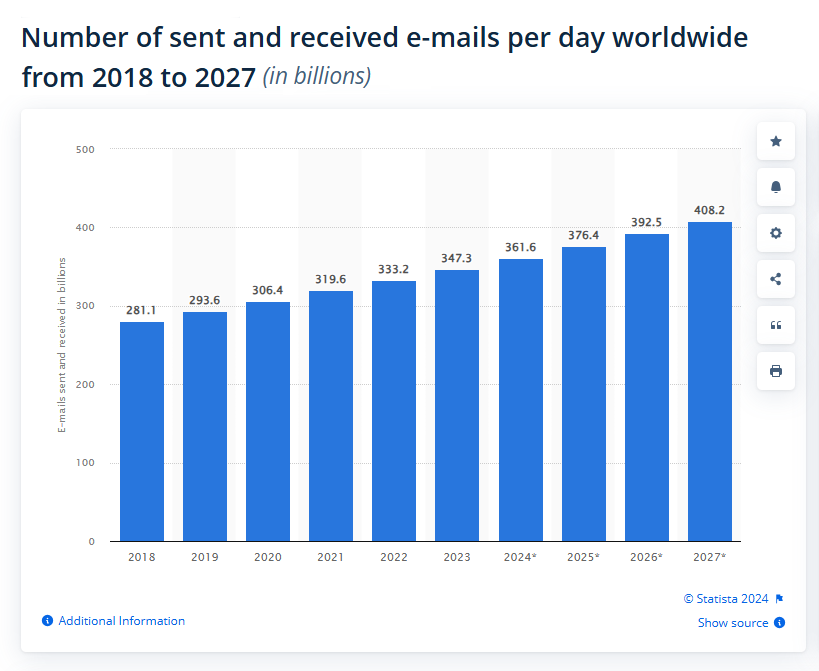
With mobile email apps like Gmail, accessing and reading emails has never been easier.
This makes email marketing one of the most effective channels for reaching leads and potential customers, offering accessibility and reach.
It has a high return on investment (ROI)
Email marketing stands out for its exceptional ROI, offering approximately $42 for every $1 spent—a return of 4,200%.
This makes it one of the most cost-effective marketing channels for businesses of all sizes.
Its success lies in delivering personalized, relevant messages directly to the right audience, achieving results that other channels like social media or SEO often struggle to match.
It’s a permission-based channel
Email marketing relies on customers willingly sharing their email addresses and expressing interest in your brand.
By obtaining permission to send your messages rather than relying on random ads, you significantly increase the likelihood of engagement and conversions.
Additionally, allowing recipients to unsubscribe ensures your email list remains healthy and engaged, helping you optimize your marketing efforts and budget.
You have an engaged contact list
Last but not least, with emails, you are the owner of your list.
This is a significant advantage, as you’re not reliant on third parties and face no risk of losing this vital asset. Every new subscriber added to your list gives you a direct line of communication with your audience.
Unlike social media platforms, where accounts and leads can vanish without notice, email ensures you retain control over your reach and engagement. Building and maintaining an email list is a long-term investment that continues to benefit your business.
Further reading: Learn why buying email lists is a bad idea and how it can harm your email marketing strategy.
Essential Types of Email Marketing Campaigns
Diversifying your email marketing campaigns ensures a more engaging and satisfying experience for your subscribers.
Here’s a breakdown of key email types to incorporate into your strategy:
1. Transactional emails
These emails are automated messages sent in response to your audience’s actions. These emails are essential for delivering crucial information and enhancing the customer experience.
Popular transactional campaigns include:
- Welcome messages: Introduce new subscribers to your brand, set expectations, and offer a warm entry point into your ecosystem.
- Confirmation emails: Notify customers about completed actions like purchases, subscriptions, bookings, or account registrations.
- Account notifications: Update customers on account activities like password resets or membership renewals.
These emails often have high engagement rates since recipients anticipate them, making them a valuable touchpoint for the customer journey.
2. Promotional campaigns
Promotional emails showcase your offers, events, and products, creating excitement and encouraging your audience to act. They can help you drive sales and increase brand visibility.
- Newsletters: Regularly share updates, tips, or curated content to keep your audience informed and engaged.
- Special offer campaigns: Highlight special deals, discounts, or exclusive promotions, enticing recipients to purchase.
- Announcements: Share significant updates, such as new website launches, products, event invitations, or business milestones.
3. Abandoned cart emails
Cart abandonment messages help recover lost sales by targeting customers who added items to their shopping cart but didn’t complete their purchase. They remind customers about their unfinished journey and encourage them to return.
- Single reminders: A one-time message highlighting the items left behind and providing a fast and easy way to checkout.
- Abandoned cart sequences: A series of emails sent over time, building urgency or offering incentives to complete the purchase.
Cart abandonment emails have impressive engagement rates, with high open and click-through rates, and nearly half of those who engage ultimately complete their purchase.
4. Lead nurturing emails
Lead nurturing emails are crafted to guide potential customers along the buying journey by addressing their needs and providing value at every stage. These emails build trust and move leads closer to conversion.
- Educational campaigns: Share insights, tips, or solutions to help leads make informed decisions.
- Product showcases: Highlight features or benefits tailored to the recipient’s interests or challenges.
- Exclusive content: Offer guides, case studies, or tools that resonate with where they are in the sales funnel.
These emails strengthen relationships with prospects and position your brand as the right choice when they’re ready to buy.
5. Re-engagement messages
Re-engagement emails aim to reconnect with inactive subscribers or customers who haven’t interacted with your brand in a while. They rekindle interest and remind recipients of your value.
This email category usually includes:
- “We miss you” campaigns: Acknowledge inactivity and invite recipients to re-engage.
- Incentive-based emails: Include discounts, loyalty points, or special offers to reignite interest.
- Product updates: Share new features or improvements that might entice disengaged customers to return.
Re-engagement emails are crucial in maintaining a healthy sender reputation by targeting inactive subscribers.
By encouraging them to engage or cleaning your list of unresponsive contacts, you reduce bounce rates and spam complaints, ensuring better deliverability and email performance.
6. Upsell and cross-sell emails
These marketing campaigns focus on increasing customer lifetime value (CLV) by encouraging additional purchases. They cater to existing customers by offering complementary or upgraded options.
- Upsell emails: Recommend higher-tier or premium products to enhance the customer’s experience.
- Cross-sell messages: Suggest related items that complement what the customer has already purchased.
Upsell and cross-sell emails help businesses capitalize on existing customer relationships, driving additional revenue through targeted recommendations.
7. Customer relationship-building emails
This email type aims to nurture deeper connections with your audience, foster loyalty, and turn customers into brand advocates. They prioritize the relationship over immediate sales.
- Surveys: Gather feedback through polls, questionnaires, or NPS surveys to improve customer satisfaction and engagement.
- Milestone campaigns: Celebrate personal or brand-related milestones like birthdays, anniversaries, or achievements.
- Loyalty program emails: Keep customers informed about rewards, points balances, and exclusive perks.
Email Marketing Examples
In this section, you’ll find some essential email marketing examples a growing business needs. The purpose is to give you inspiration and ideas for your future email design.
Tsuki – Abandoned cart email campaign
Subject line: Quick! Here’s a discount on your purchase…
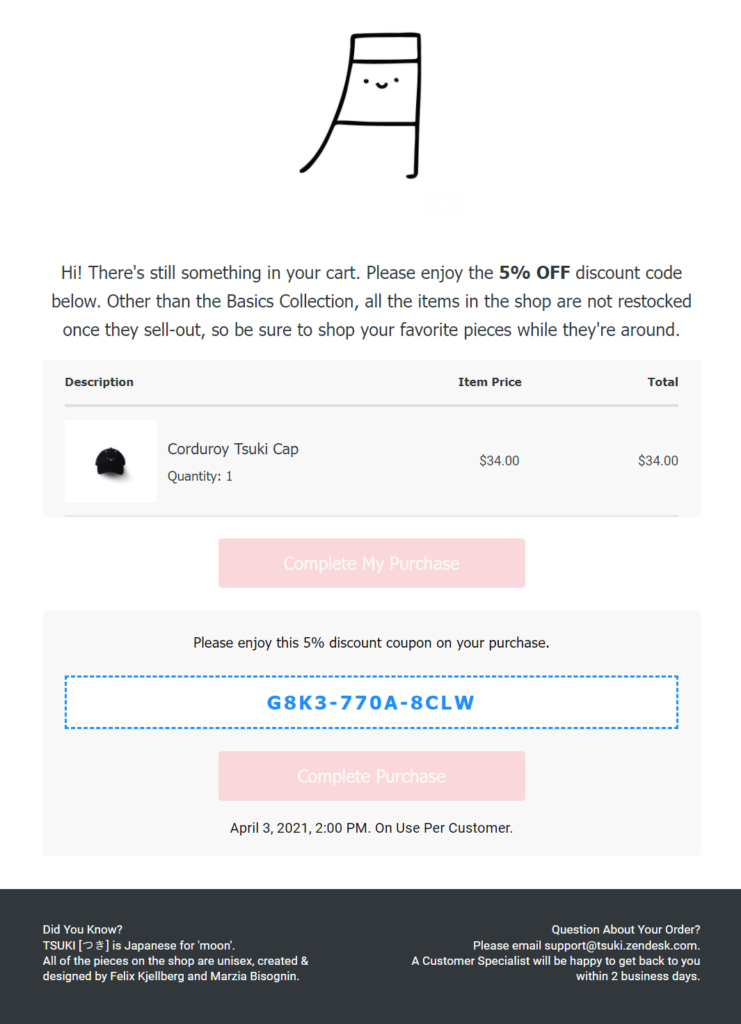
Why it works: This abandoned cart campaign from Tsuki is a masterpiece of simplicity and effectiveness. The subject line is perfect since it immediately attracts your attention and prepares you for a discount on something you plan to buy.
As for the email design, it is clean and elegant without unnecessary elements. The email copy also creates a fear of missing out (FOMO) as it informs customers that once items sell out, that’s it. No restocks.
Tomorrow People – Educational newsletter example
Subject line: Marilia, here’s your resource pack to achieve stronger sales pipelines

Why it works: This educational email by Tomorrow People combines valuable content with actionable insights.
The visually engaging layout highlights clear sections like product tips, competitive analysis, and an in-depth eGuide, effectively guiding readers to resources that solve specific pain points. Strong CTAs like “DOWNLOAD NOW” drive action and deliver measurable value.
ModCloth – Promotional email campaign
Subject line: Treat yourself this Thursday with $29 dresses!
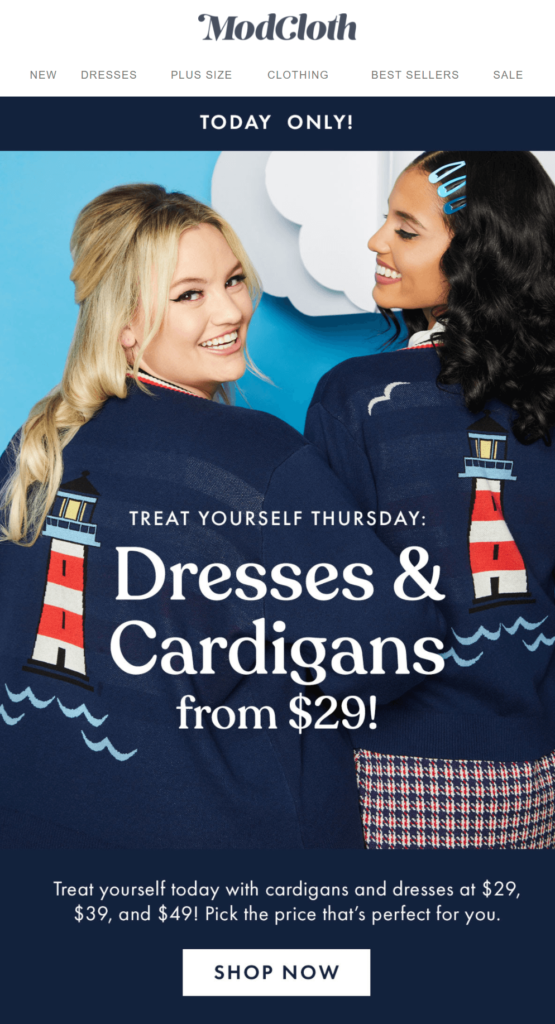
Why it works: ModCloth uses clever messaging to promote its products. The brand plays with the contrast of blue and white to create a visually pleasing result.
The email copy is minimal, and the job is mostly done with the headline. Overall, it’s a useful email catering to the reader’s short attention span.
Starbucks – Customer loyalty campaign
Subject line: Your free plays are waiting
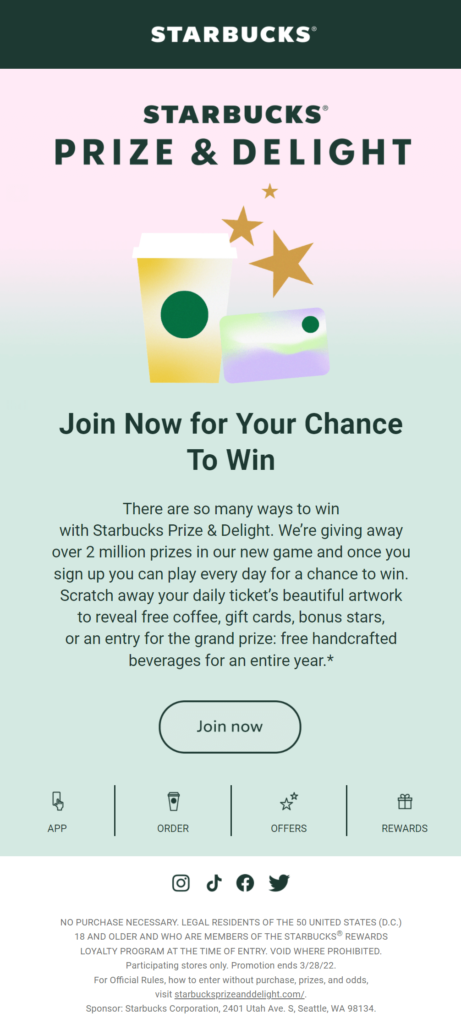
Why it works: In this customer loyalty email campaign, Starbucks uses the color palette of the brand while the visuals employed subconsciously support the message.
As for the email, it has a short copy with a clear CTA (“Join now”) that leads users to the desired action.
How to Get Started With Email Marketing in Easy Steps
So you’re probably going to ask: “How am I going to get started with email marketing?”
Luckily for you, we’ve created a full video tutorial on how to get started with email marketing, from registering on an email marketing platform to sending your first campaign:
Or you can keep reading here.
Everything will be broken down into easy steps to ensure your first email marketing campaign’s success.
Step #1. Select an Email Marketing Platform
The first step is choosing a top-notch email marketing service to equip you with the right tools. I know well that it might feel a little tiring to browse through endless email marketing services.
Especially when they all look the same at first glance; however, there are two key factors you need to consider to make your life a little easier:
Email marketing platform cost
The cost is key when you’re starting. Many platforms offer a free email plan or free trial of their features.
If you are on a tight budget, we highly recommend using it to fully test the features. On the plus side, a free plan/trial is perfect for helping you make a data-driven decision when the time for a paid plan comes.
Tip: A free plan/trial is great to help you start. As your list grows, you’ll need a tool to help you scale your business without breaking the bank.
Regarding the available pricing models, email marketing services tend to charge by email volume or the number of subscribers. The first model is more suitable for businesses who want to send a certain number of monthly email campaigns.
The second pricing model is a better fit for most businesses as it doesn’t restrict the number of emails you can send while pricing scales with your business growth.
Email marketing software essential features
Another critical factor you need to consider is the features your email marketing tool gives you.
Whether you go for a free plan/trial or choose one of the best email marketing services on the market, you should never compromise with something that gives you less than you need.
To give you a hand, here are some of the best options out there:
| Pricing | Free Trial/Plan | Unique Feature | |
| Moosend | $9/month | Yes (30-day trial) | Easy-to-implement automation |
| Brevo | $9/month | Yes | SMS marketing options |
| ActiveCampaign | $15/month | Yes (14-day trial) | Event tracking options |
| Mailchimp | $20/month | Yes | Multi-step custom workflows |
| Constant Contact | $12/month | Yes (60-day trial) | Event invitations management |
| AWeber | $15/month | Yes | Email testing across devices |
| MailerLite | $10/month | Yes | Opens by location |
| Benchmark | $15/month | Yes | Easy-to-use editor |
With this in mind, your email marketing software should have the following:
- Drag-and-drop email builder: a user-friendly editor will help you design your emails and customize your templates without having any technical skills.
- Email templates: ready-made newsletter templates to save valuable time and inspire you.
- Variety of email campaigns: your platform should provide you with different types, including A/Testing, RSS, automation campaigns, etc.
- Segmentation and personalization options: targeting your audience with the right message requires sophisticated tools to divide them based on specific criteria.
- Integrations: integrating your tool with popular applications is the best way to streamline your marketing efforts.
Last but not least, it could prove valuable if the email marketing software you chose has all-in-one capabilities. From subscription forms to landing pages, an all-in-one tool will help boost your email marketing efforts and increase your email signups.
If you want a robust and practical all-in-one solution that combines email marketing with subscription forms and landing pages, you can always sign up for a free Moosend account and see how everything works.
Windows Report has recently selected Moosend as a modern solution to deliver email marketing. Windows Report is a highly trusted web resource for all things Windows, including news and tips for tech users.
Step #2. Grow Your Email List
You’ve chosen the platform that best suits your needs. Now the time has come to do the second most crucial step, email list building.
There is one thing, however, that you need to keep in mind. You always need to get permission from your audience before you start emailing them. Therefore, it’s essential to have a clear purpose when requesting an email address.
There are numerous ways to approach growing your list. Let’s break them down.
Add an opt-in form to your website
A simple opt-in form on your website is probably the first thing you should do. Most ESPs on the market now let you create subscription forms that you can easily embed into your website.
Here is an example from the popular brand MeUndies:

To create a successful opt-in form, you must be clear about your audience’s expectations. For example, what kind of email content they will receive, how often communication will occur, etc.
Stick to your promises, or you risk annoying your subscribers, leading them to unsubscribe or flag your emails as spam. This would be detrimental to your email deliverability rate.
Use lead magnets & content upgrades
To maximize your efforts of attracting more people, you need to offer something valuable for free. As we mentioned before, this is called a lead magnet.
Lead magnets are mostly digital materials such as PDFs, videos, etc., costing little or nothing to create. They can be practically anything as long as the audience can use them immediately.
For example, here is a real eCommerce lead magnet from MVMT in the form of a discount:
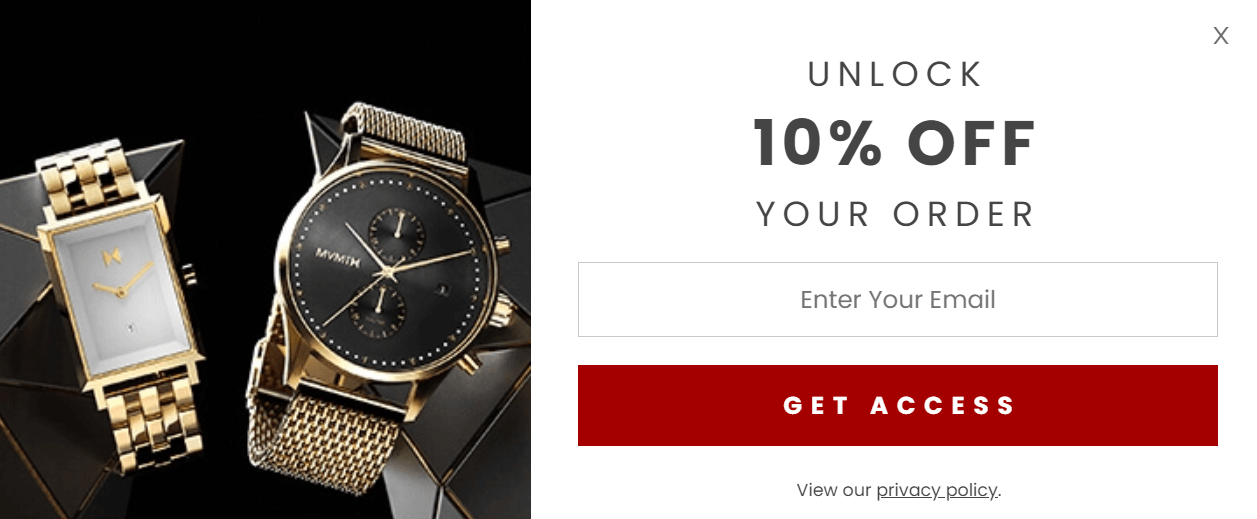
For an eCommerce business like MVMT, 10% off is valuable for new customers who want to save some money.
You can also entice people to sign up by using different subscription form types:
- Floating bars: discreet and attractive bars that you can use as newsletter signup forms.
- Exit intent pop-ups: offer an extra, highly valuable resource before your visitor leaves to boost signups without interrupting the user experience.
- Floating boxes: they slide and stay on the visitor’s page as they scroll down. Usually contain a strong call-to-action that encourages the visitor to subscribe
- Full-page: forms that cover the visitor’s entire page to attract attention.
Leverage social media
Last, you can also grow your list by tapping into social media.
If you have active social media accounts, share your signup form to increase your email subscribers.
Tip: Never purchase email lists online because they will harm your business instead of helping it. This is because those addresses you buy have not permitted you to send them promotional messages, and as such, they will flag you as a spammer if they don’t recognize you.
Step #3. Segment Your Email List
Segmenting your audience into groups with similar interests is one of the best email list management practices. Why? Because without proper segmentation, your email efforts will be ineffective.
Creating targeted groups enables you to create tailored content that will address your customers’ pain points and provide them with unique solutions.
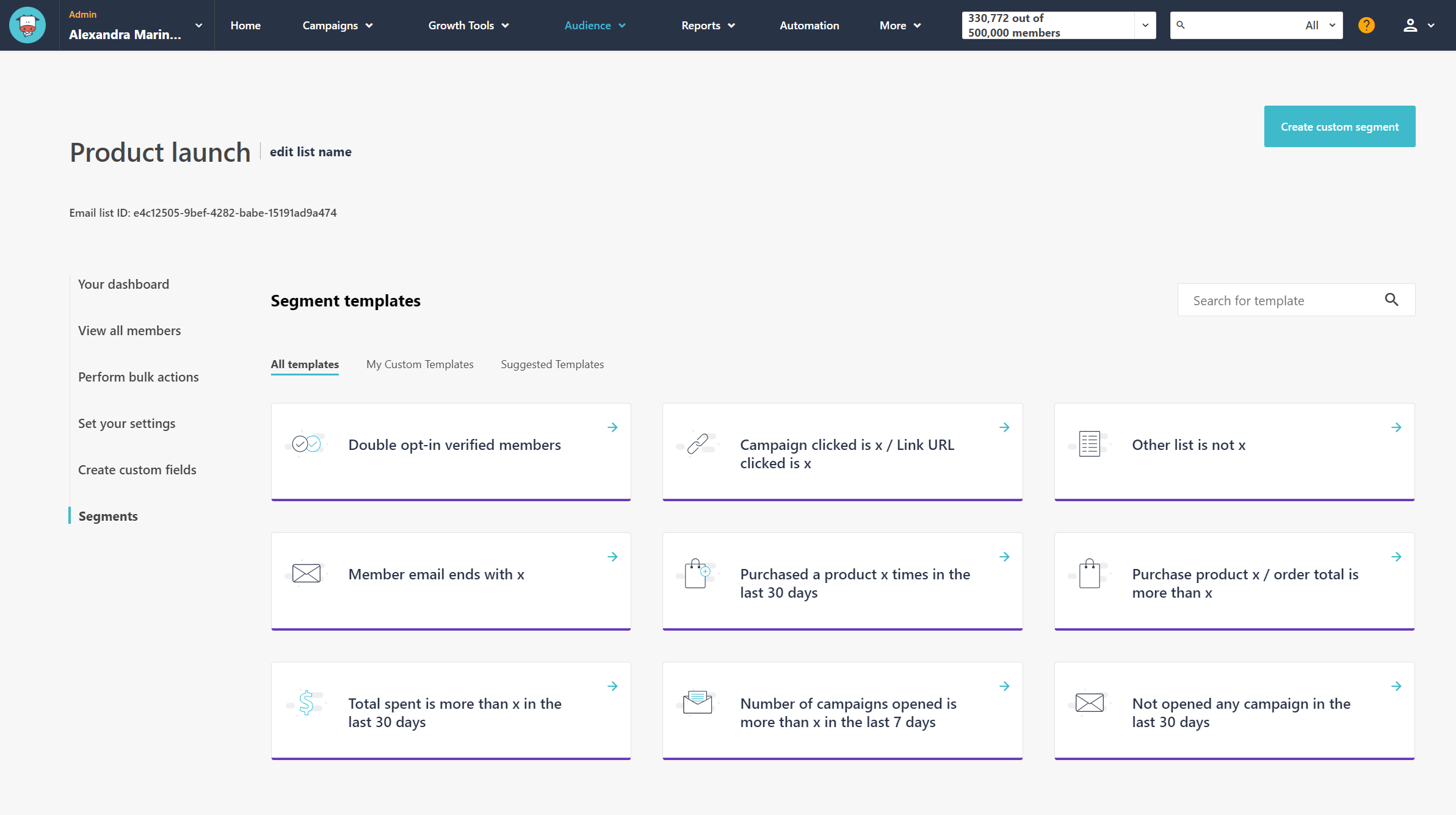
Segmenting can help your business in numerous ways. It can improve open rates by sending relevant content to the right recipient, boosting click-through rates, decreasing unsubscribes, and contributing to fewer spam complaints.
Below, you’ll find some of the best segments you can create:
- Demographics: group based on gender, age, marital status, family size, income, education, nationality, etc.
- New subscribers: send them a welcome message or a welcome email series to build trust and establish a relationship that will lead to a sale.
- Customer list: distinguishes people who have purchased from leads who haven’t.
- One-time buyers: a bounce-back email or a follow-up offer after a purchase can turn them into profitable repeat customers.
- VIPs: the most loyal of your customers who make consistent purchases. Keep them happy by providing them with exclusive offers or loyalty programs.
- Cart abandoners: subscribers who have forgotten something in their cart and need a gentle reminder.
- Preferences: segment your audience based on whether they prefer only sales notifications or blog posts.
- Lead magnet: depending on the lead magnet your subscribers opted in for, send them relevant emails.
- Open rate: send an exclusive offer to reward your most loyal subscribers with a converting subject line.
By now, it’s evident that segmenting your list will give you an advantage over competitors who don’t.
You’ll be sending targeted emails instead of impersonal email blasts. Not to mention that this will make your life easier if you want to leverage automation, as we’ll see further in this guide.
Step #4. Create Your First Email Campaign
Now, it’s time to create a successful email marketing campaign without breaking a sweat. Let’s see how to do it.
Choose the right campaign type
There are various types of email campaigns that you can send to your subscribers. The type you’ll choose depends on the overall goal you have.
Moosend, for example, offers four main types of email campaigns: Regular, A/B Testing, Repeatable, and RSS.
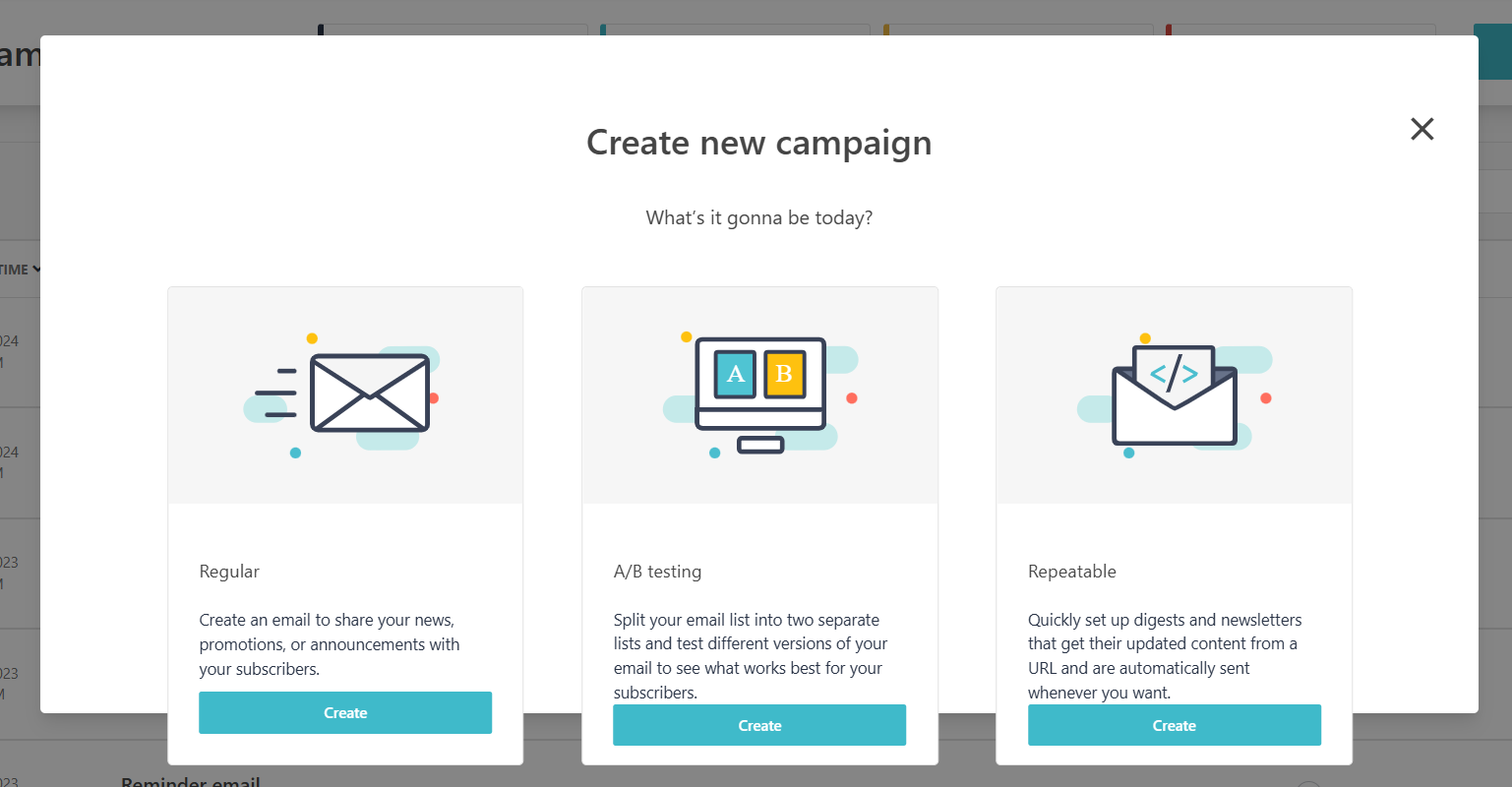
If you want to promote a new product, it would be wise to go for a regular campaign you can easily create.
For bloggers, setting up an RSS campaign would help promote your blog posts and boost your content marketing efforts through email.
As for A/B test campaigns, these allow you to send two variations of the same email to different segments of your email list and see which one works best.
Design your email marketing campaign
After choosing the appropriate campaign type, it’s time for your email newsletter design.
To get the best results out of each campaign, there are some fundamentals that you need to be aware of:
- Visuals
- Email Copy
- Personalization
- Call-to-action button
First of all, your campaign has to be structured in a way that promotes readability. A difficult-to-read or dull campaign will end up in the spam folder.
To avoid it, entice your subscribers to read your content and guide them strategically to your email CTA.
You can achieve that by using the inverted pyramid model. Here’s an eye-catching example from Morphe:
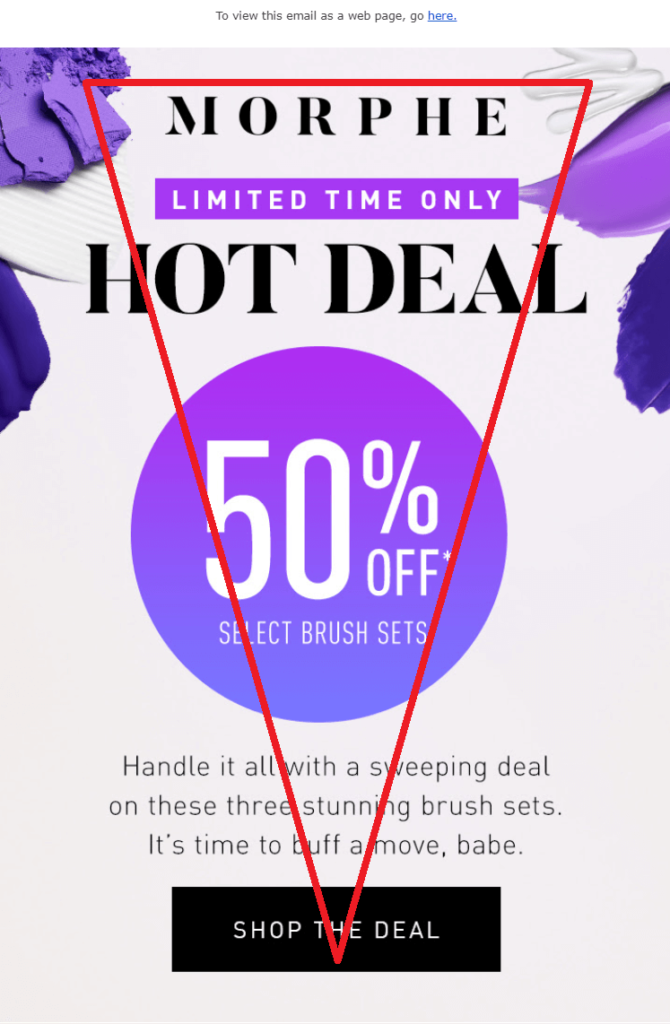
As you can see above, you need:
- a concise and catchy headline with the key message of your campaign
- high-quality newsletter images to persuade the reader
- a converting CTA to show them what to do next
All of the above are essential to ensure a high click-through rate and more conversions.
Generally, you don’t want to clutter your email with too much text or information. Adding visuals will help you avoid walls of text and make your email unique and memorable.
Moreover, when it comes to your email copy, try to keep it short, on-point, and relevant to your subject line.
Just take a look at this successful email marketing example by GUESS:
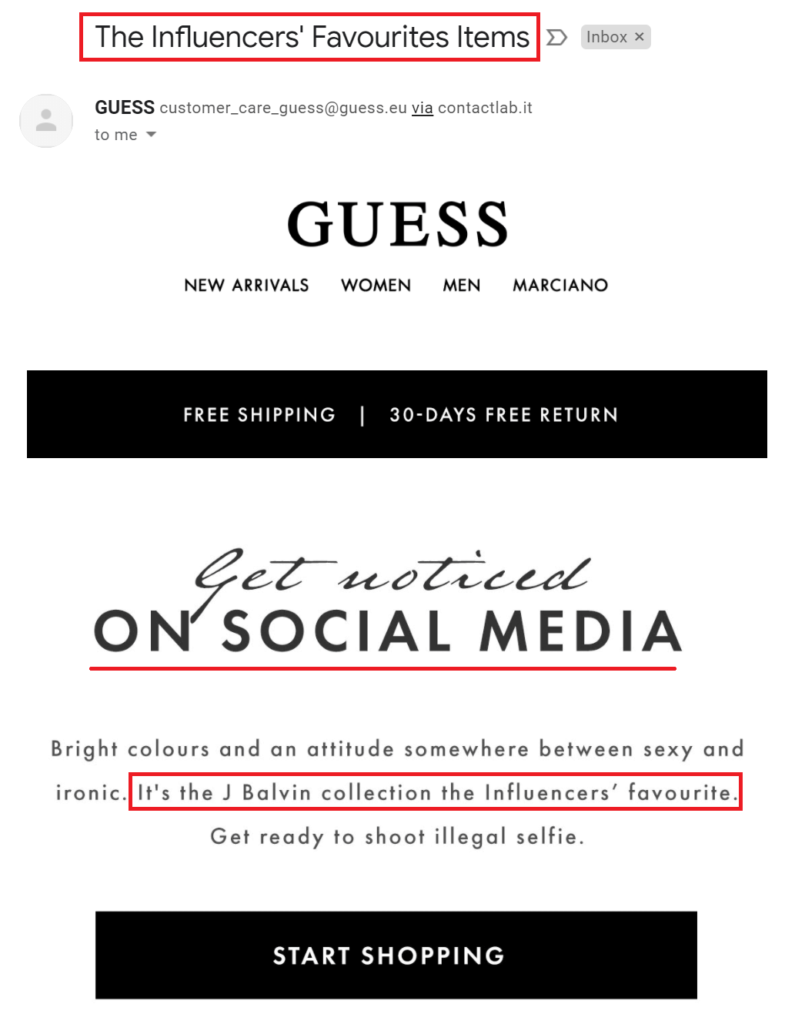
Also, don’t forget that personalization is crucial if you want engaged subscribers. So, try adding their name in the subject line to personalize your email or use advanced segmentation.
Finally, your CTAs should be as clear as possible. Be sure to use consistent colors and avoid adding too many; otherwise, your subscriber will get distracted.
Tip: If you have trouble with your subject lines, get your hands on an email subject line tester to help you optimize them and boost your open rates like a pro!
Send your campaign to your subscribers
Your campaign is now ready to reach your subscribers. But first, you need to choose the segment of your email list that will receive your email.
As we’ve said before, relevance is vital, so you don’t want to “annoy” all your subscribers unless necessary based on your goals.
Next, you need to ensure the email deliverability of your campaign. Weak content, bad designs, and unresponsive email templates negatively impact your deliverability.
Avoiding spammy email subject lines and including a visible unsubscribe link at the footer like MOO will do the trick:
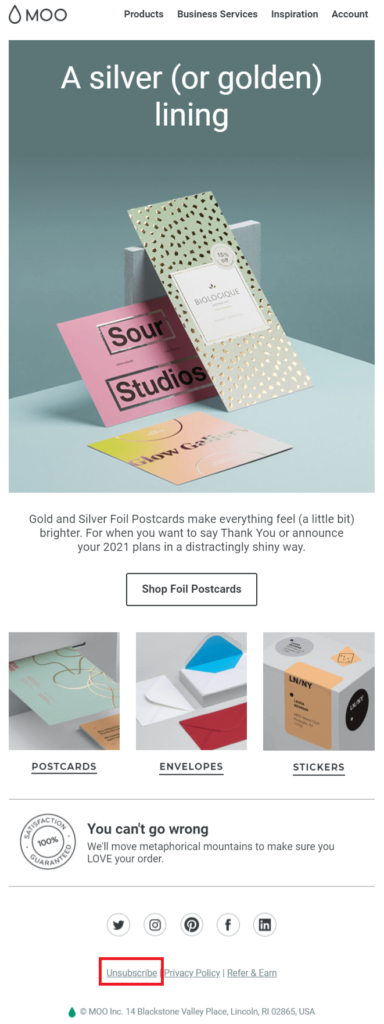
We know this isn’t what you wanted to see, but according to some of the best email marketing practices, they might report you as spam if you don’t give your uninterested subscribers a way out. This will inevitably harm your sender score.
Also, remember that many people will read your emails on a mobile device, so your campaign needs to be mobile-friendly.
After you’ve done all these, you shouldn’t forget to run a spam test using an email tester tool to check whether your email lands in the inbox of popular email clients like Gmail, Outlook, and Yahoo.
And, finally, you have to schedule your delivery. You may want to send it immediately or schedule it for a specific time to ensure maximum impact.
Advanced email marketing tip for beginners: There is always the chance that some people will not open your email campaign. You can enable automated resending to non-openers. This can be valuable since you may double your open rate with minimal effort!
Step #5. Leverage Email Marketing Automation
If you’re just starting, it’s possible to send and reply to every one of your subscribers. However, as your list grows and your campaigns become more complex, sending hundreds of emails manually will be impossible.
This is where marketing automation comes into play. Using autoresponders, you can send automated emails to segments of your list after a specific event happens.
For instance, when someone signs up for your newsletter or leaves products in their shopping cart.

Above, you can see a simple cart abandonment workflow you can set up through your email marketing automation platform. This automation allows you to be “present” with all your subscribers and not go dark for long periods.
Furthermore, it helps you form a strong relationship with your subscribers and nurture them into potential customers. Generally, creating an automation sequence can be a tad advanced for beginners, but you’ll eventually get familiar with it.
If you want to go in-depth with email automation, especially for your eCommerce business, this guide is a real eye-opener.
Step #6. Measure Your Performance & Optimize
Now, it’s time to take things to the next level.
To get the most out of your email campaigns, you need to track their performance and identify areas that can be improved.
Almost every email service provider offers complimentary reporting and analytics, which you can find in the Reports tab of your email marketing tool.
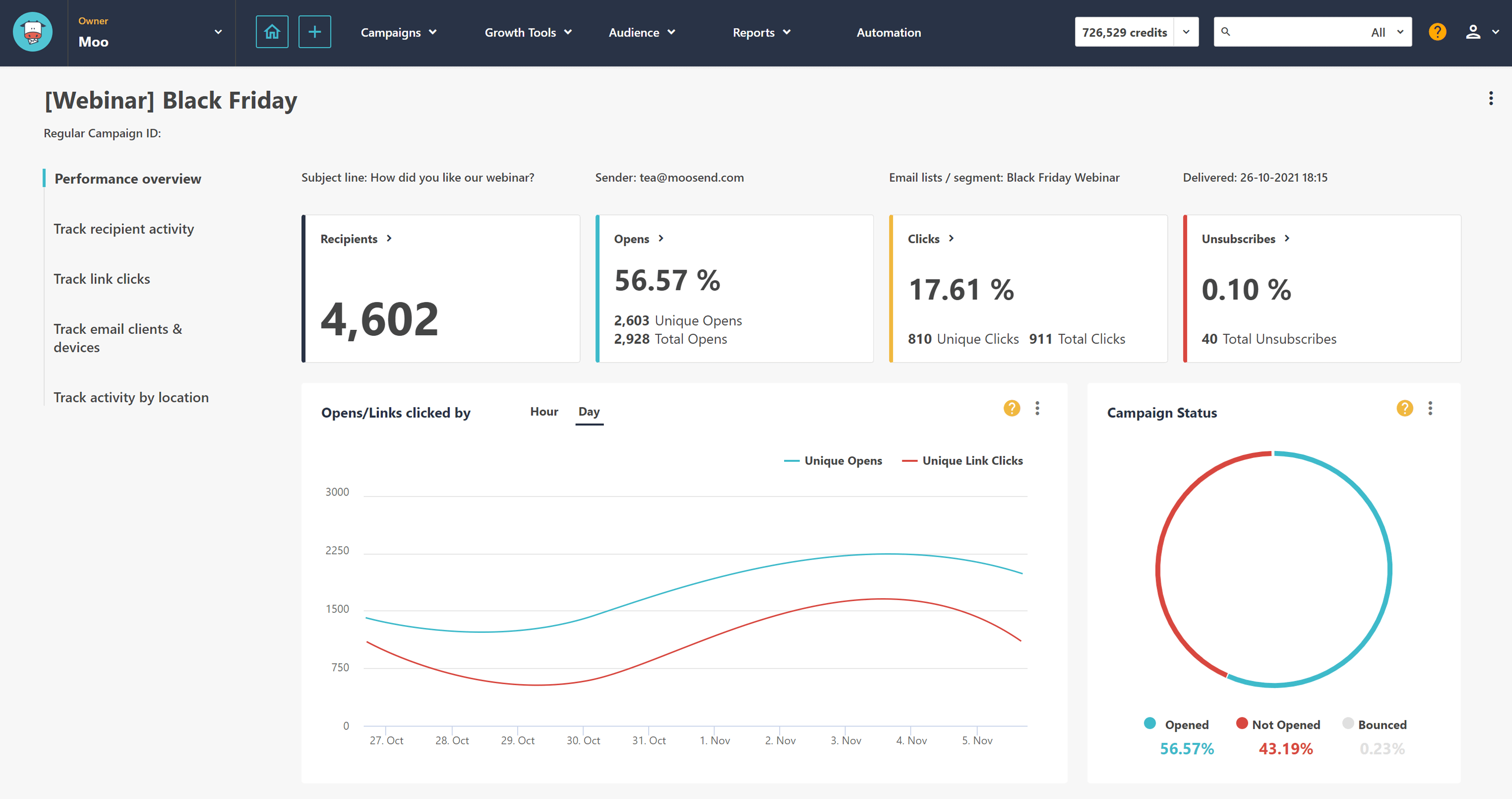
Some of the metrics you’ll encounter are the following:
- Number of unique opens and clicks
- Open rate
- Click-through rate
- Unsubscribe rate
- Bounce rate
- Number of spam complaints
The three key metrics you should focus on as you start should be your open rate, click-through rate, and unsubscribes.
What reporting tells you about your campaigns
First, your open rate illustrates the relationship you have formed with your subscribers.
Ideally, they should be able to open your emails and read them quickly. If the open rate is low, your subscribers are likely unengaged.
You can provide more value to them and meet their expectations. Also, the usual suspect for low open rates is usually a spammy subject line.
So, why not add your subscriber’s name to make it more engaging? Also, running A/B tests can help you find what makes your audience open your campaigns.
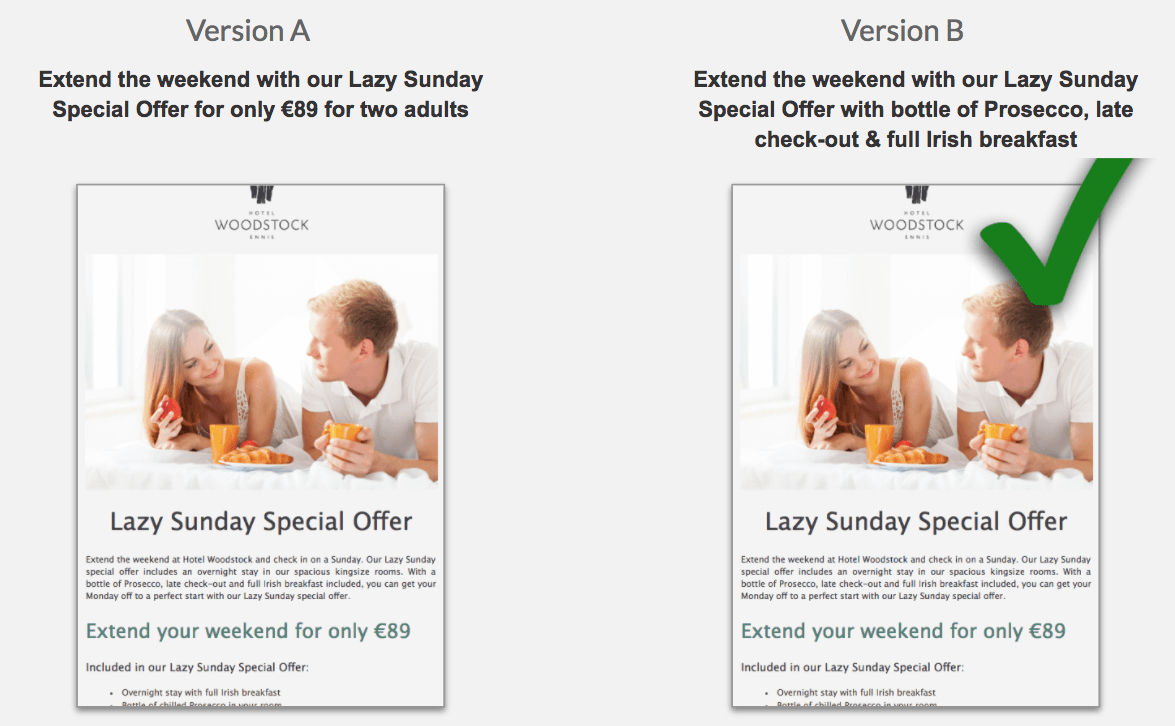
Moreover, your click-through rate (CTR) shows how many people clicked on a link in your email. If this is low, your mail isn’t targeted enough, or your copy isn’t as compelling as it should be.
To tackle this, consider improving your copy and using A/B Testing for CTA placement. You can take a step further and examine what happened after people clicked a link and landed on your website, which you can do by integrating Google Analytics with your platform.
Finally, unsubscribes are very common and, I’d say, unavoidable. High unsubscribe rates, though, indicate that you’re losing potential customers.
If that’s the case, you need to figure out why they are leaving and act.
Think of the following: Did I deliver upon the promises I gave? Are autoresponders sending the correct targeted message? Am I sending too many sales emails instead of providing value first?
Whatever the case, the takeaway is that you need to pay close attention to what the data shows and act.
Important Email Regulations
Speaking of data, did you know that staying compliant isn’t just a legal necessity but the foundation for building trust with your audience?
Email regulations are designed to protect recipients from spam, ensure transparency, and maintain ethical marketing practices. Non-compliance can lead to penalties, tarnished sender reputations, and even legal action.
Understanding and adhering to them ensures your campaigns reach inboxes and resonate with recipients in a way that creates long-term relationships.
Here’s what you need to know about key email regulations and how to comply with them effectively.
General Data Protection Regulation (GDPR)
GDPR applies to businesses targeting EU residents and emphasizes the importance of explicit consent in email marketing.
Under this regulation:
- You must have explicit consent before sending emails.
- Recipients must know how their data will be used.
- Provide clear options to unsubscribe at any time.
Tip: Use double opt-in forms to collect explicit consent and maintain accurate records, ensuring full compliance.
CAN-SPAM Act
The CAN-SPAM Act targets businesses sending commercial emails in the United States and focuses on transparency and fair practices.
Under this regulation:
- You must include a clear and visible unsubscribe link in every email.
- Avoid using misleading subject lines or headers.
- Identify the email as an advertisement or promotional content.
Tip: Use email marketing platforms that automatically include unsubscribe links and validate compliance with CAN-SPAM requirements.
Canada’s Anti-Spam Legislation (CASL)
CASL involves email campaigns sent to Canadian recipients and sets strict rules for obtaining and managing consent.
Under this regulation:
- Obtain express or implied consent before emailing recipients.
- Provide clear sender identification and contact information.
- Include an easy and visible way to opt out of future emails.
Tip: Regularly audit your email list to ensure only consented and engaged recipients remain.
Australian Spam Act
The Australian Spam Act concerns businesses sending commercial electronic messages to Australian recipients, emphasizing consent and content accuracy.
Under this regulation:
- Ensure you have explicit or inferred consent before sending emails.
- Include accurate sender information in all emails.
- Provide a functional and simple unsubscribe option.
Tip: Use clear language in your email campaigns and ensure unsubscribe requests are processed promptly to maintain compliance.
How to Stay Compliant
Now that you know the major email regulations let’s see a few email marketing best practices to ensure your efforts are transparent and respectful.
- Get clear and informed consent: Use opt-in forms that explicitly explain what recipients are subscribing to. Avoid vague language or pre-checked boxes, which can lead to misunderstandings or non-compliance.
- Process unsubscribes quickly: Make it easy for subscribers to opt out and honor requests immediately. This not only ensures compliance but also shows that you value their preferences.
- Keep detailed records of consent: Track when and how subscribers gave consent. This is particularly important for regulations like GDPR and CASL, which require proof of consent in case of audits.
- Communicate data usage transparently: Clearly state how subscriber data will be used and stored. Always include a link to your privacy policy in your emails to reinforce transparency and trust.
By focusing on consent, transparency, and subscriber autonomy, your campaigns will remain compliant and strengthen audience loyalty and engagement.
Take Your First Email Marketing Step
If you have been ignoring email marketing, it’s time to get your hands on it!
Of course, to do that, you need a great email marketing tool to help you and email marketing become best friends. And if you feel like it, don’t forget to try Moosend by signing up for a free account!
To succeed, always ask for permission, deliver upon your audience’s expectations, and send targeted messages to the right people at the right time. Once you master this, you’ll have better results than ever.
Frequently Asked Questions on Email Marketing (FAQs)
Here, you’ll find some of the most frequently asked questions regarding email marketing.
1. When is the best time to send a marketing email?
Based on various analyses, the best time to send a marketing email is between 9 and 11 am. The next best time slot that also works well is 1-2 pm as most consumers have their lunch break at that time, so they are more likely to check their emails.
2. What is email marketing automation?
Email marketing automation is the strategy of sending triggered email messages to subscribers on your email list. These personalized email messages are sent automatically to prospects or customers when they make a predetermined action or a condition is met.
3. How much does email marketing cost?
To run successful email marketing campaigns, you’ll need as low as zero upfront investment, depending on the email marketing service you choose. Opting for a dedicated employee or agency to do your email marketing would cost anywhere from $15 to $100+ per hour.
4. What is the average open rate for email marketing?
The average open rate for email marketing across all industries is 21.5%. While this number is a great starting point to have in mind, you should look at industry-specific numbers to establish whether your businesses’ open rates are within normal limits or they have room for improvement.
5. What is the best email marketing service?
There are several great solutions in the market right now, such as Brevo, Omnisend, Mailchimp, and Campaign Monitor, but Moosend is the best solution among them due to its advanced functionality, ease of use, and affordable pricing that scales as your business grows.
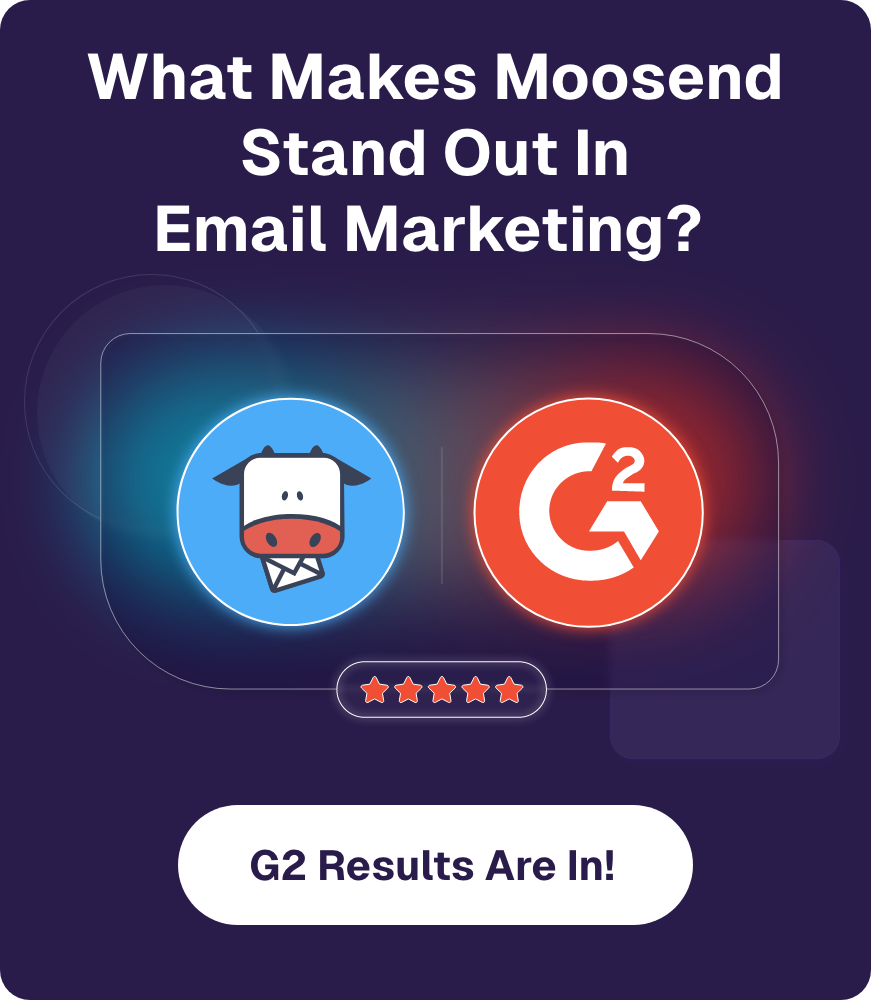

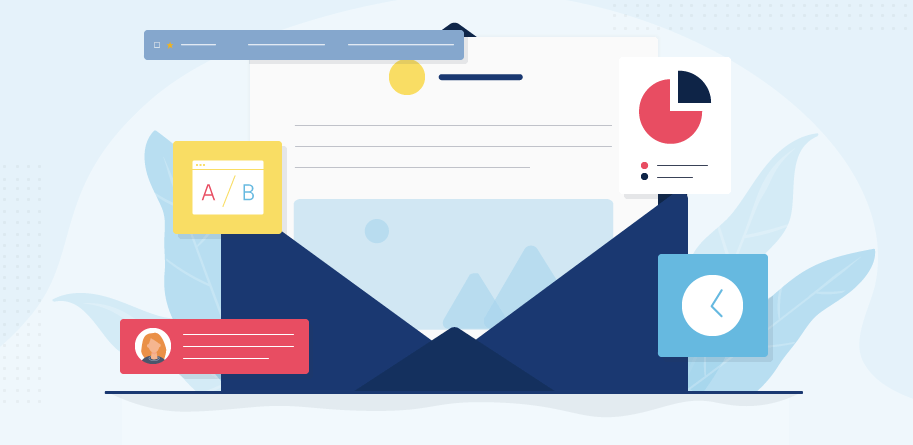
 Published by
Published by
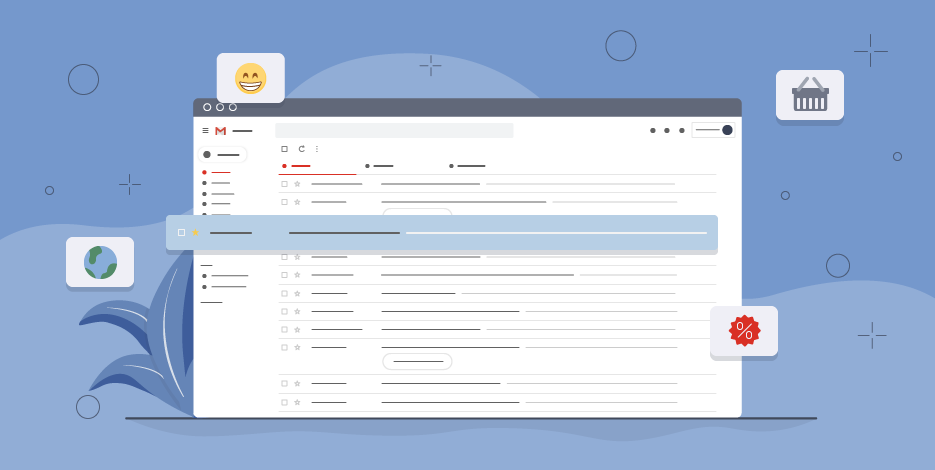
 Published by
Published by